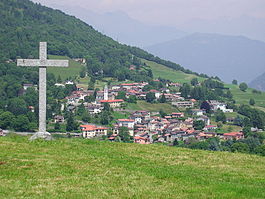Alto Malcantone
| Alto Malcantone | ||
|---|---|---|
 |
||
|
||
| Coordinates: 46°2′N 8°53′E / 46.033°N 8.883°ECoordinates: 46°2′N 8°53′E / 46.033°N 8.883°E | ||
| Country | Switzerland | |
| Canton | Ticino | |
| District | Lugano | |
| Government | ||
| • Mayor | Sindaco | |
| Area | ||
| • Total | 21.92 km2 (8.46 sq mi) | |
| Elevation | 810 m (2,660 ft) | |
| Population (Dec 2015) | ||
| • Total | 1,421 | |
| • Density | 65/km2 (170/sq mi) | |
| Postal code | 6937-6939 | |
| SFOS number | 5237 | |
| Surrounded by | Aranno, Bedano, Bioggio, Cademario, Curiglia con Monteviasco (IT-VA), Gravesano, Indemini, Manno, Miglieglia, Sigirino, Torricella-Taverne | |
| Website |
www SFSO statistics |
|
Alto Malcantone is a municipality in the district of Lugano in the canton of Ticino in Switzerland. It was formed on 13 March 2005 from the earlier municipalities of Arosio, Breno, Fescoggia, Mugena and Vezio.
Arosio is first mentioned in 1335 as Aroxio. Breno is first mentioned in 1140 as Breno. Fescoggia is first mentioned in 1296 as Fescozia. Mugena is first mentioned in 1214 as Megiadina. In 1270 it was mentioned as Migena. Vezio is first mentioned in 1355 as Vecio.
According to tradition, the Roman road leading from Ponte Tresa to Monte Ceneri Pass ran through Arosio. By the Middle Ages it was a central town in the upper Magliasina valley, which was at that time was known as the Valle d'Arosio. The villages of Arosio, Breno, Cademario, Mugena Tortoglio and Vezio formed an economic and political unit.
The Church of San Michele is first mentioned in 1217. In 1640-47 it was totally rebuilt. It contains a cycle of frescoes by Antonio da Tradate and notable stucco work by local artists from the 17th and 18th Centuries. At one time, the architects and master builders of Arosio operated throughout Europe.
The local economy was based on agriculture and herding in the alpine meadows. In recent decades the services sector dominated the local economy. After 1960, a number of new houses were built in the village.
Archaeological digs have uncovered items from the Roman era in Breno. The village name is Celtic in origin, though the exact meaning is unknown. At some time after the year 1000, the Abbey of S. Abbondio in Como acquired some rights and land in Breno. The municipality bought itself out from under those rights in 1579. Modernly, the village includes the south land that once belonged to the municipality of Tortoglio. This land was abandoned in the wake of a plague in the 15th century. The village was involved in a land dispute with Miglieglia until 1890.
...
Wikipedia




